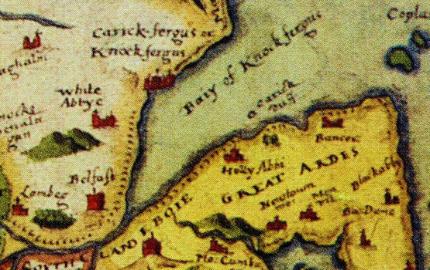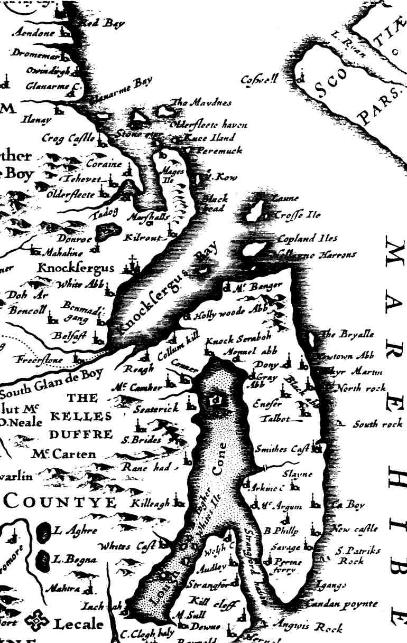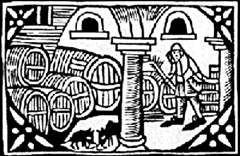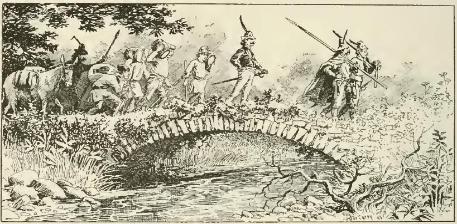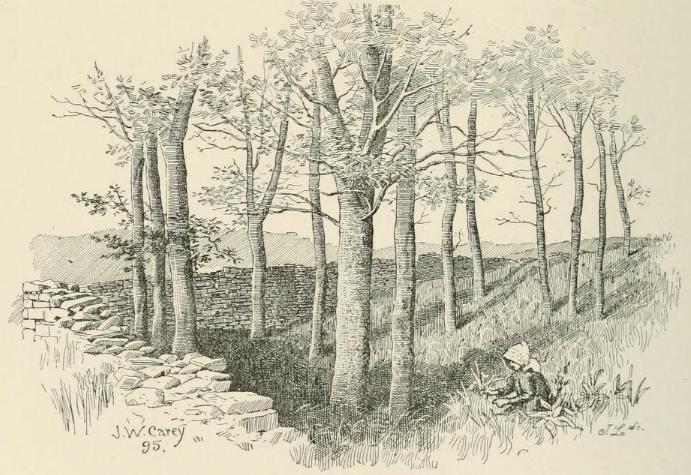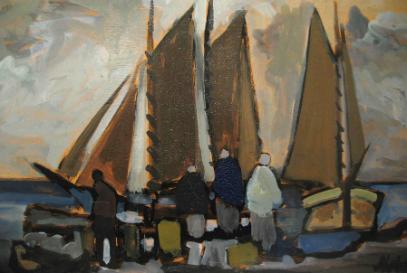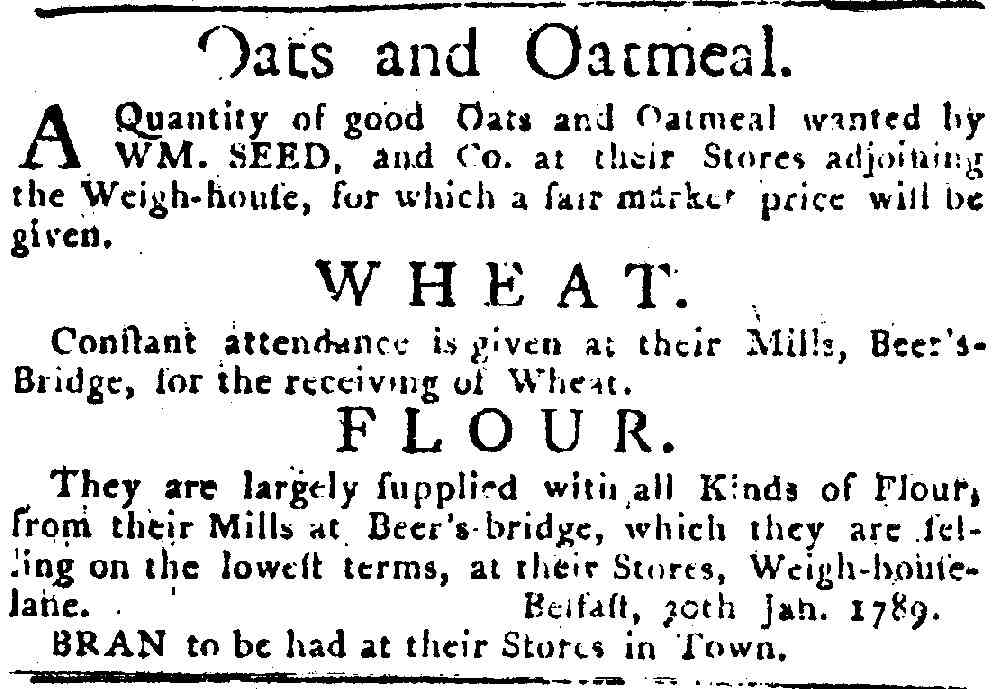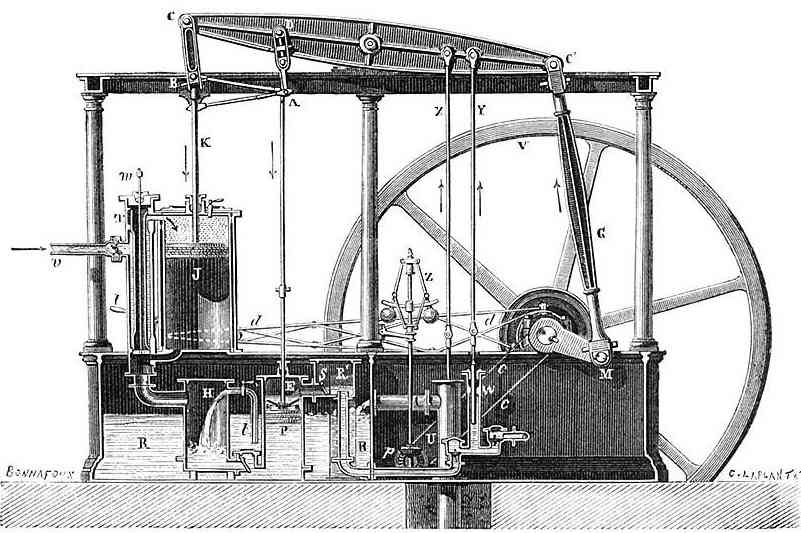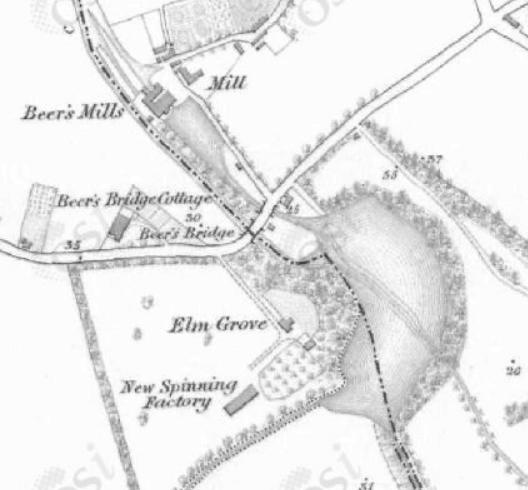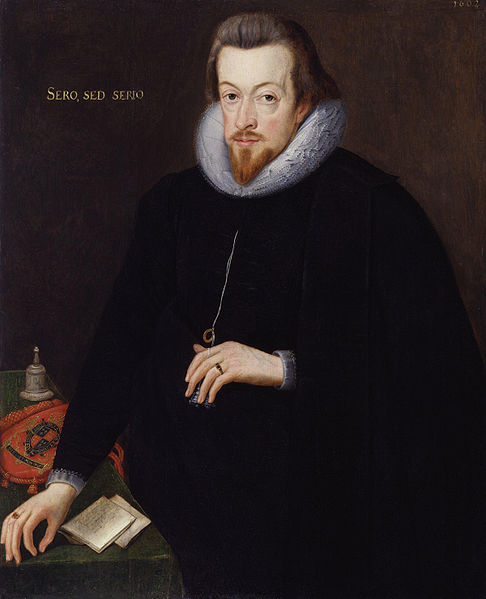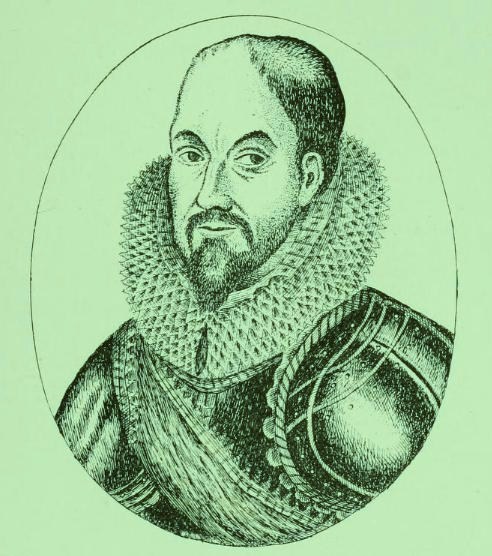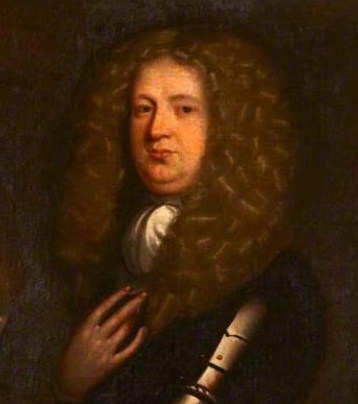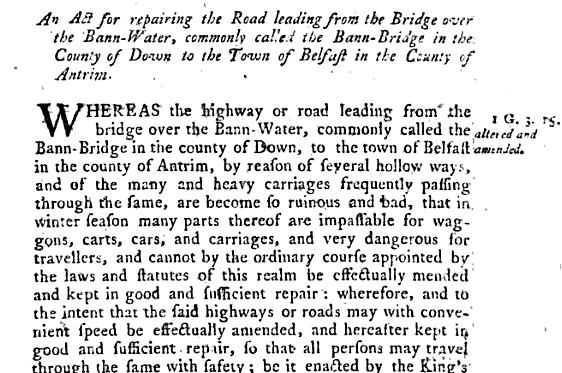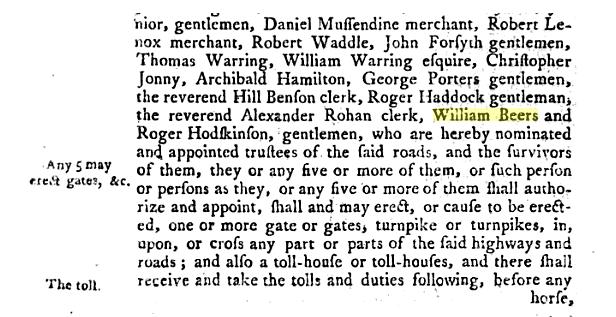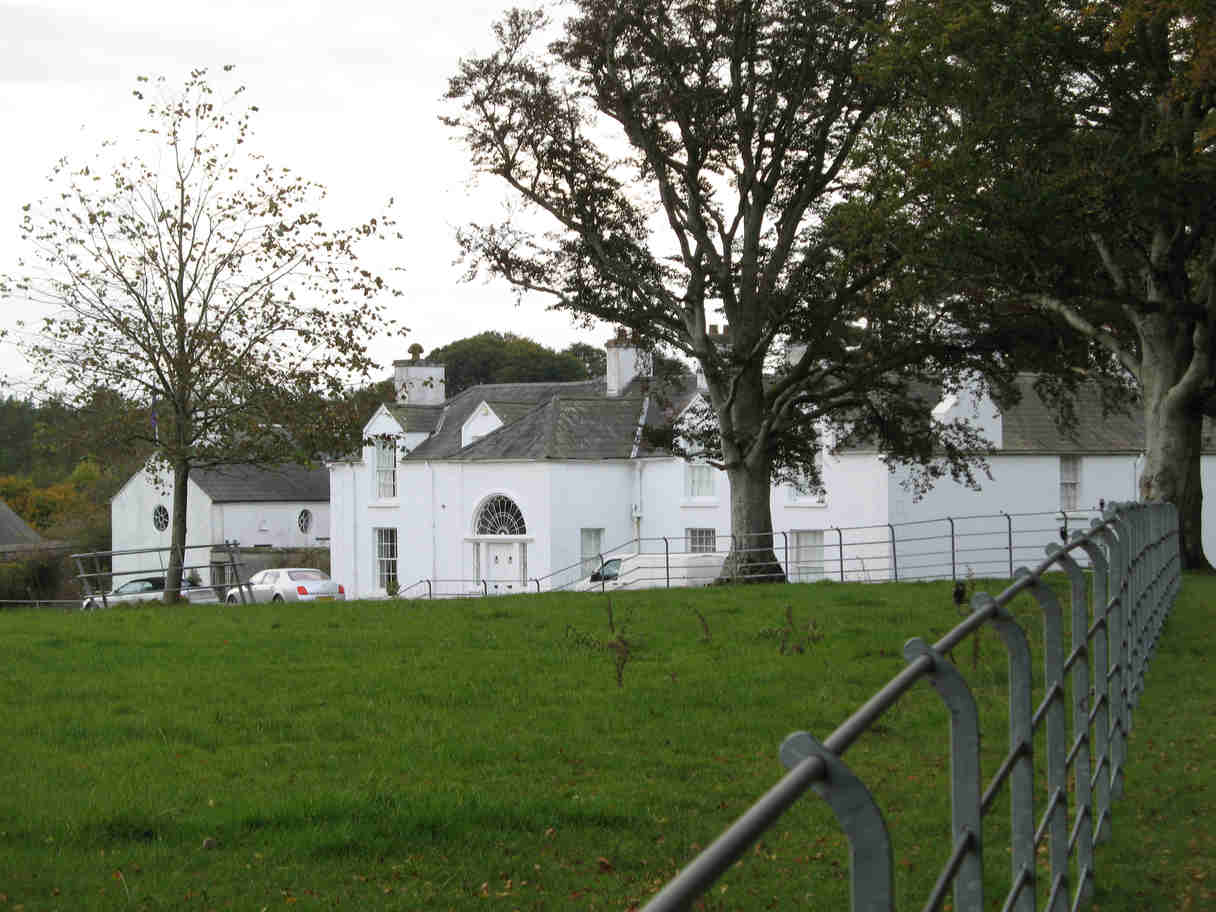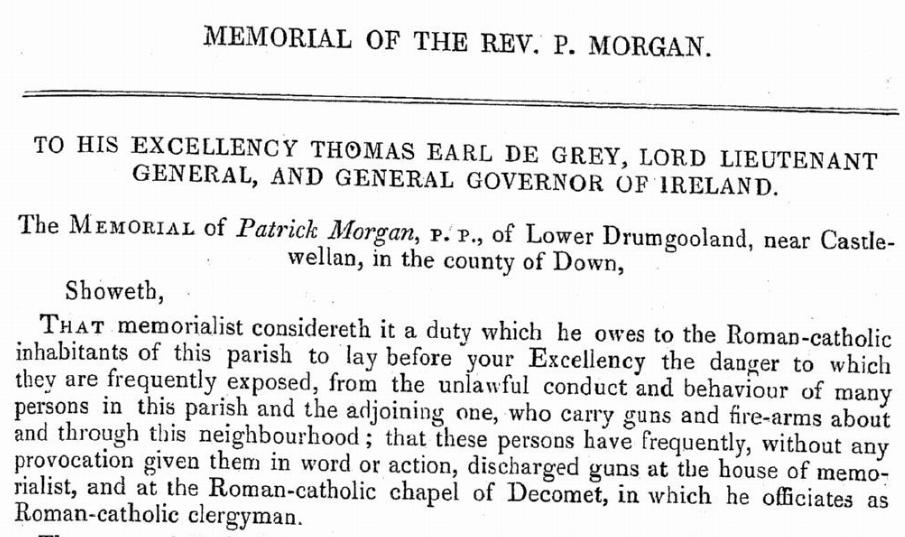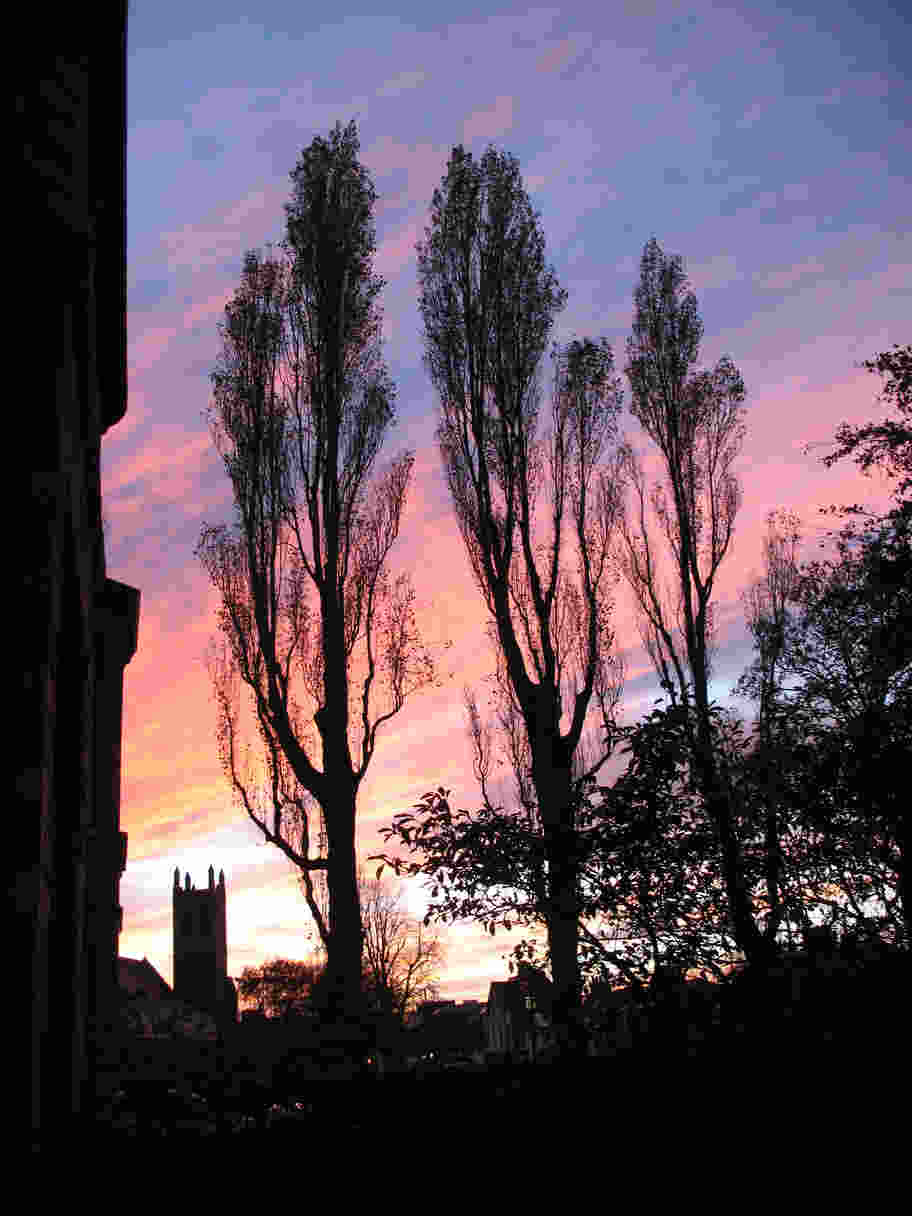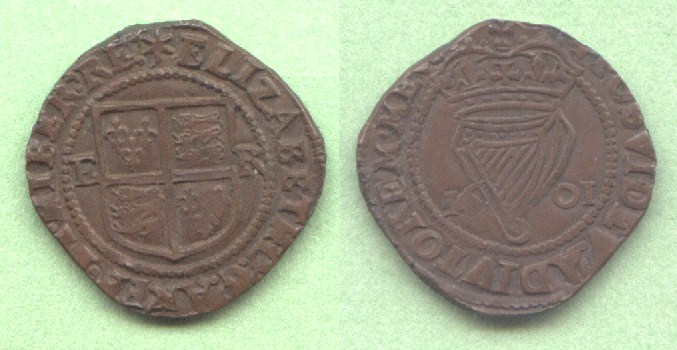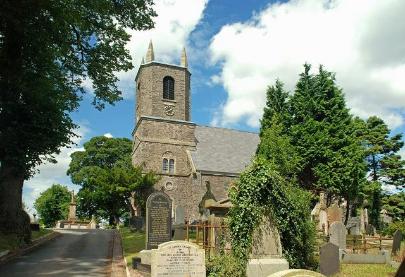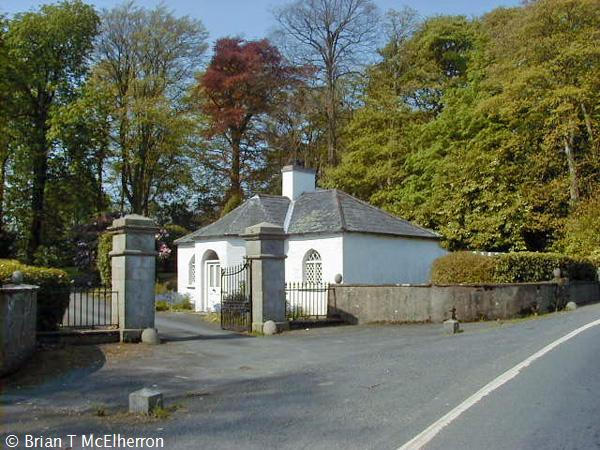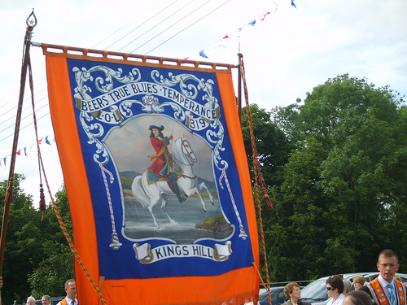This page looks at the early history of the area eventually to be known as Bloomfield. It focuses on the Owen O'Cork Mill and the Beere or Beers family.
The page concludes with a lengthy digression on the colourful Beers family in South Down, much of it breaching the 1775 dateline, and reaching far into the 19th century.
Oliver Goldsmith (1730-1774), in his poem The Deserted Village, was worried about the future of the peasantry
because of the conversion of good agricultural land into ornamental
landscaped gardens.
That was around the time (1770) when the little town of Belfast was already surrounded by estates with their ‘big houses’.
And Belfast then was indeed but a little town.
For many of the previous centuries it had been just a village.
A small Norman fort had been built there in the 12th century at the point where a sand bank allowed the River Lagan to be crossed at low tide.
Hence Belfast’s name in Irish: Béal Feirste (Béal meaning the mouth; Feirste meaning sand-bank).
So Belfast was the mouth or the approach to the sand-bank crossing point.
Lagán in Irish is a low-lying district, through which the river flowed, and so that became the river’s name.
Detail from the 1602-1603 map, a Generalle Description of Ulster.
On the southern side of the Lagan from Belfast is County Down and the parish of Holywood with its townland of Baile an Chacamair, Ballyhackamore, the ‘townland of the slobland’. The name refers to the mudflats and marshland, but it also serves as a reminder that, before land reclamation, Ballyhackamore had previously been much closer to the sea.
These lands had belonged to the O’Neills with their seat at An Caisleán Riabhach, Castle Reagh, the ‘grey castle’. Conn O’Neill, Lord of Upper Clandeboye and the Great Ards, was the last O’Neill to live there.
Towards the end of 1602, following a dispute about wine, some of O'Neill's men killed an English soldier from the Belfast garrison. O'Neill was imprisoned in Carrickfergus jail but managed to escape to Scotland in 1604 with the help of Hugh Montgomery and the sort of devious plot that would make a great costume drama!
The matter was resolved when Conn O'Neill eventually 'agreed' to divide his lands in three. He kept half of Upper Clandeboye with Castlereagh "and circumjacent lands". The rest was divided between Sir Hugh Montgomery and a cousin of King James I: Sir James Hamilton, later Viscount Clannaboy whose son would become the first Earl of Clanbrassil.
“… The said Sir James Hamilton to have liberty to import all such corn and commodities from England, Scotland or from any friendly State, at the accustomed duties, into the said territories, to enable him to perform his undertaking of inhabiting the same, being now depopulated and wasted, with English and Scottish men …”
A 17th century map, printed in Amsterdam. Original was said to have been at Orangefield [House], Belfast (Stevenson, John. Two Centuries of Life in Down).
King James I to Sir Arthur Chichester, Lord Deputy of Ireland,
16 April 1605. (Carte Papers, Vol. 61, page 145).
These were interesting times. The Nine Years' War in Ireland came to an end barely a week after Queen Elizabeth I died in March 1603. Ulster had been brought starving to its knees by Sir Henry Docwra and Sir Arthur Chichester's scorched earth policy which resulted in a severe famine. The war had brought England close to bankruptcy and probably cost over 150,000 lives on both sides - and this at a time when England was at war with the Spanish Netherlands.
James VI of Scotland became James I of England in July 1603.
Two years later, in 1605, there was the Gunpowder Plot when Guy Fawkes failed in his attempt to blow up the House of Lords, and King James with it.
The Flight of the Earls took place in 1607. The Gaelic lords fled from Ireland, hoping to raise backing in Europe for a new war. That was not to be. As a punishment for this treachery, their lands were confiscated in 1608 and settled mainly by Scots in King James's Plantation of Ulster from 1609 onwards.
From 1606 onwards however, Hamilton and Montgomery began to settle war-torn and desolate Co.Down (and Co.Antrim) with Scots who set about improving the land and building houses, farms and churches.
Conn O'Neill was not a good businessman, selling off his land bit by bit and eventually selling his castle in 1616 to Sir Moyses Hill (of the Downshire family).
In May 1622, both Hamilton and Montgomery were rewarded by the King for their achievement in the "pacifying of Clandeboye, after rebellion, in the tumults of the peasants of Ulster; also, in pacifying of Ardes, in our kingdom of Ireland, a colony of Scots being brought in the beginning of our reign over from Great Britain into Clandeboye and Ardes ..." (The Hamilton manuscripts, page 13).
Conn O’Neill’s name lives on in Conn’s Water, the river formed from the confluence of the Knock and Loop rivers.
Writing in The Industrial Archeology of Northern Ireland (HMSO, 1980, page 34), W.A. McCutcheon mentions that
Click on each thumbnail to see a larger version.
“... in suburban Belfast, off the Beersbridge Road at Abetta Parade, ‘Conn O’Neill’s Bridge’ though probably not so old as it is often reputed to be, does lie on a trackway which led from the tidal creek at the mouth of the ‘Conn’s Water’ or Owen O’Cork river to the O’Neill stronghold in the Castlereagh hills.”
George Benn refers to this little bridge in his 1877 A History of the Town of Belfast, Vol.1, also dispelling myths about King William of Orange, not of Orangefield! See this PDF:
RH pic: Conn O'Neill's bridge drawn by the well-known artist Joseph William Carey (1859-1937) who was an illustrator for Marcus Ward & Co., which, in 1896, published R. M. Young's Historical Notices of Old Belfast and its Vicinity.
The PDF below is a transcript from The Rev. James O’Laverty’s An Historical Account of the Diocese of Down and Connor … Dublin, 1880. (Vol.2 – Castlereagh or Upper Clannaboy from page 180 onwards).
This PDF details the drunken
fight between Conn O'Neill's men (above) and the English soldiers; the subsequent capture and imprisonment
of O'Neill; Montgomery's rescue of O'Neill; and the eventual division and dispersal of
O'Neill's lands.
LH pic: J.W. Carey's 1895 sketch of the site of Conn O'Neill's castle. It was published in R. M. Young's Historical Notices of Old Belfast and its Vicinity, Belfast, 1896.
Fishing rights are mentioned in documents from 1623 and 1644 relating to the Owen O'Cork mill (see the PDF of Owen O'Cork historic references below).
It's difficult to imagine now that the Connswater River was once a trout and salmon river, but it's thanks to the river that the Owen O’Cork mill, in various guises, has been a consistent fixture across the centuries, re-inventing itself from the original corn-mill to become a flour mill, then a flax, cotton and jute mill, and now a home for several small businesses, an auction house and artists' workshops.
RH pic: Awaiting the boats, by Markey Robinson (1917-1999).
A booklet, The Gaelic Placenames of Belfast, published in August 2012 by Belfast City Council, in partnership with the Ultach Trust, clarifies that Owen O’Cork was not the name of a person. It is “based on the similar-sounding Abhainn an Choirce, ‘the river of the oats’, indicating that an earlier corn-mill stood there when the area was still Irish-speaking.”
The mill is also mentioned in the 1670 and 1672 Clanbrassil rent rolls - "Owen Quirk" in 1670; "Owen O Cork" in 1672.
"Owen O'Corke" is another frequently encountered spelling. Less common is "Oyn O'Cork" and simply "Owen Corke".
The mill came with a ferry boat (presumably to Belfast town, but just as likely to places such as Carrickfergus) and with 12 acres of land attached - six in Ballyhackamore, six in Ballymacarrett. See this PDF:
Even better for the mill's proprietor, if you lived in Ballymacarrett, Ballyhackamore, Knock, Ballycloghan, Strandtown, Ballymechan or Ballymiscaw and you chose not to use the Owen O'Cork mill, you had to pay a fine to the Owen O'Cork.
Win, win all the way for the proprietor at that time (1672), John Wilson.
The Ordnance Survey Memoirs of Ireland reported on the parish of Holywood in September 1834:
“There is a large flour mill at the south western point of the parish called Beer’s mills, with a mill pond.”
One assumption is that this was either the Owen O’Cork mill, or a newer building on the site of the former Owen O'Cork mill.
The photos on the right (click to enlarge), taken in 2012, are of Garrylough Mill, Screen, Wexford. It was established in 1689, but rebuilt in 1831 by Maurice Roche.
With an oak wood wheel, it was Ireland’s last working water-powered flour mill and shows what Beer's mill might have looked like.
The Hamilton manuscripts detail several leases relating to the Owen O'Cork mill, right up to the very late 18th century, never mentioning a Mr Beer(e). See the PDF below - which also refers to salmon fishing in 1623 in Conn's Water, or more accurately, "in the river and baie of Owen O’Corke".
Pending more evidence, the mill may have been rebuilt in the early 18th century and one of the Beers family (of Edenderry House) discussed below was possibly associated with it then.
There is also a valid case to support the better theory that the Beers name association relates to the mid 17th century and a much earlier generation, probably of the same family.
An indirect link is supplied by the Beere gravestone in Knock graveyard (detailed below). It includes a Richard Person [sic], who died in November 1647, likely to be the father or son (or just maybe the same person, no pun intended) of Richard Pierson who is mentioned in the next PDF relating to 1650.
Being on the same gravestone as the Beere family might suggest that that Richard Person or Pierson was a son-in-law (or brother-in-law, or father-in-law) of the William Beere who erected the gravestone.
See the section below on Who was Mr Beer/Beere/Beers?
RH: PDF of references to the Owen O'Cork mill in the Hamilton manuscripts:
The
name “Beer’s mill”, used in the 1834 Ordnance Survey map, is an inherited name from many, many
years earlier, certainly prior to 1783. That was when the mill was leased by Barry Yelverton to
William Seed and Co., and became a flour mill.
Yelverton, Attorney General for Ireland in 1782 and then Lord Chief Baron of the Exchequer in 1783, was created Viscount Avonmore in 1800.
He bought Ballymacarrett from the Pottinger family in 1781 for £18,113 5s 0d. Six years later he sold it to the 1st Marquis of Donegall for £25,000.
LH pic: Advertisement from the Belfast News Letter, January 1789
Far LH pic (hover and click on the thumbnail): Advertisement from The Belfast Mercury; or, Freeman’s Chronicle, Friday, 10 September 1784, page 1.
Near LH pic: Advertisement from The Northern Star, Thursday, 3 December 1795, page 4.
In 1791, with a nod to the Industrial Revolution, William Seed was in correspondence with James Watt who made various calculations about Seed’s requirements. Whether then, or later in 1808 when a new engine was completed for William Seeds and business partner Robert Baillie “much to their satisfaction”, Beer's mill had entered a new era, supplementing and replacing water power with steam power.
The engineer, Joseph Varley, wrote to his employers, Boulton, Watt & Co. (Soho, Birmingham) on 29 January 1808, explaining that he “has been obliged to run away from Seed & Baillie’s to avoid a Matrimonial Connection [his or theirs?]. Proposes taking his passage for Liverpool on Sunday. Requests directions to his next destination.”
James Watt's steam engine, c.1788
A 1744 account of North Down including Holywood, Castlereagh and Knockbreda
RH PDF: Excerpt from Page 69 to Page 74 re north Co. Down from Harris, Walter and Smith, Charles. The Antient and Present State of the County of Down … Dublin, 1744.
Harris and Smith mention Gentlemen's Seats in 1744 in
the barony of Castlereagh; Holywood and its mussels; Scrabo quarries;
Comber; Saintfield; Drumbo; Ballylesson; Purdysburn; Belvoir; Knockbreda
Parish Church and its architect Richard Castle (or Cassels or Cassel) (1690-1751);
Castle-Reagh and Con O'Neill.
Who was Mr Beer/Beere/Beers?
The eponymous Beer or Beere or Beers, whose name has been enshrined in the mill, the bridge and the road, remains a mystery.
No clear evidence seems to have been produced to prove who he was. Given the relative rarity of the surname, I believe he was most likely connected to one of the Beere/Beers people detailed below.
The
Beersbridge Road was the main route out of Belfast to parts of Co.Down before the new road, the Great Scots Road [i.e. the
Newtownards Road], was built in the years after 1750.
The Connswater Bridge on that new Newtownards Road dates from 1759/1760. This PDF (below) was the 1758 tender for its construction, as advertised in the Belfast News Letter on 7 July 1758:
Click to enlarge. These pics are of the current Beer's Bridge, the first one revealing the widening on each side of the bridge.
In earlier years, a road bridge over Conn's Water on the Beersbridge Road would have been essential.
But when was that stone bridge built?
Mr Beer(e) was perhaps the first person to build that bridge, or to fund its building, or to improve something that was already there.
On the 1834 Ordnance Survey map, there's a Beer's Bridge Cottage, Beer's Bridge and Beer's Mills. Note how the mill is further down stream than the later 19th century "Owen O'Cork" mill which is adjacent to the Beersbridge Road.
We know from the 17th century rent rolls that the proprietor of the Owen O’Cork mill in 1667/1670 was John Wilson.
Mr Beer's activities must date from before that, or at some time between c.1680 and 17 September 1758, when Beer's Bridge is mentioned in a Belfast News Letter advertisement for land surveyor Samuel Strean.
Importantly, Mr Beer must have been someone with money!
The lack of any Beere's mention in the Hamilton manuscripts is disappointing, to say the least.
The Beer(e) family name is Anglo-Saxon, with its origins in the south of England.
My first thought was that a family member may have served in one of the levies sent to Ireland from an English county such as Kent during the Nine Years’ War (1594-1603) which led eventually to the Plantation of Ulster.
Helpfully for this theory, Sir Arthur Chichester, who became Lord Deputy of Ireland in 1605, is known to have favoured the awarding of land to veterans of the War.
It was difficult and hugely expensive to fund the English military effort in Ireland during the Nine Years’ War - and yes, a certain Mr Beere played his part.
Sir George Carey (c.1541-1616), wrote to Sir Robert Cecil, Secretary of State (1563-1612) in 1600:
I
see by experience that these Irish wars do exhaust the treasure of
England, that the state of England doth even groan under the burden
thereof, [and] that we expend faster here than you can gather it in in
England.
LH pic: Sir Robert Cecil, Secretary of State, painted c.1602 by John de Critz the Elder.
How could they ensure that the Irish rebels were unable to use the regular silver coinage to buy arms?
The solution, in 1601, was to introduce a new debased coinage for Ireland, replacing the silver English coins with copper ones. Exchange into this new token currency was mandatory in Ireland.
But who would willingly exchange silver for copper?
The new coinage was not readily accepted.
The two coinages were exchangeable initially at face value. Strict regulations were also imposed about the movement of monies between England and Ireland. Despite that, there was much illegal trafficking between the two coinages and, clearly, plenty of opportunities for fraud.
The merchants could profit through ‘dodgy’ transactions, but the government officials and the soldiers found themselves unable to buy goods and services.
Low morale and mutiny were in the air.
Sir George Carey, Treasurer-at-War in Ireland, became Master of the Exchange with responsibility for the exchanges in London, Bristol, West Chester, Dublin, Cork, Galway and Carrickfergus.
In 1601 Carey appointed Edward Beere as Master of the Exchange in Carrickfergus, Sir Arthur Chichester’s base (Challis, C.E., The Tudor coinage for Ireland, British Numismatic Society, 1971).
This was an important role, changing money from English to Irish and vice versa, paying the army and ensuring that anyone travelling into the country reported to the Exchange and delivered to Mr Beere,
“such
sterling money as they brought with them for moneys current within this
kingdom; and if it be suspected that any passengers or others do not
deal truly in the delivery of any of the said sterling money, that then
our officers of the said Exchange, and our officers of our Custom in the
said ports, may search such passenger and passengers to see what
sterling moneys they have. And also that the Master of the Exchange may
put all and every such passenger and passengers on their corporal oath
to open the truth what moneys of the old decried sterling moneys they
have brought with them, directly or indirectly.”
From a Proclamation by Queen Elizabeth I, Dublin Castle, 24 January 1602 [1603] (National Archives. Full text here.)
All did not go smoothly – as Sir Arthur Chichester (pictured on the right) had reported to Sir Robert Cecil on 16 January 1602:
… The misery of this country is very great; nothing to be bought for this new coin but in the town among ourselves, no Scot or other will receive it, their trading for small sums will not bear their charge in seeking it returned from the places of exchange, which not with standing a Scot had lately broke the lodging and Chest of Mr. Beere the Exchange master resident and taken out five hundred and odd pounds which was 14 days in his possession undiscovered – but being apprehended we regained the money and executed the party who had no partner [accomplice] …
… from Knockfergus [Carrickfergus], this 16th of January, 1601 [1602].
Your honour’s true and faithful servant,
ARTHUR CHICHESTER.
Did Edward Beere stay in Ireland, maybe rewarded by Chichester with a gift of land for his services?
Or perhaps Edward invested his earnings in the neighbourhood of Belfast in the parishes of Knockbreda and Holywood?
Might Edward's son be the William Beere whose family is buried in Knock graveyard?
Knock Burial Ground, in the parish of Knockbreda, and only a short distance from Beer’s mill, has a headstone (recorded in Memorials of the Dead, X, 30) which reads (punctuation is an editorial addition):
Here lyeth the body of Richard Person who ded in Novr 1647,
Also Deborah, Daughter to William Beere, ded in June 1649,
Also Ann Summer, wife to William Beere, ded in Decem 1650,
[Also] Henry Novell, sonne of Georg Novell, de in 1651,
Also John, sonne of William Beere, de January Ano 1653 and
Richard, sonne of Samuel Beere, ded in Anno 1653.
This was most likely the Beere
family, English in origin, which profited from Chichester's patronage
and which was then - or at a later stage - associated with the mill,
road and bridge now bearing the Beere name.
And,
as already mentioned, surely Richard Person is a very close relation
indeed to "Richard Pierson, who hath a lease of the said townland
[Ballymacarrett] for seven years, to and at All-saints, 1650"?
(Hamilton manuscripts, pp. 55-57). Perhaps he was a father or son - or
even the same person who died three years before his lease was up?
I have no doubt that
the William Beere (or Beer or Beares) of Knock graveyard is the same
man mentioned in the 1659 Census of Ireland.
Under the 'Castellreagh Barrony', in the townland of 'Bally McConnoghy' in the parish of Blaris and Bredaghs, there is William Beares, gent. So William Beere or Beares was a significant land owner in the area. See PDF on the right.
One of the listed Commissioners for Co Down in that Census was William Bear, Gentleman. Surely the same man again?
The Public Record Office of Northern Ireland (PRONI) holds many interesting documents and letters relating to the family. First must be the listing under Down Diocesan Wills for 1671 of "William Beere, occupation: Gent, Ballymaconaghy."
Was this the William Beere of Knock graveyard or a son? Whichever it was, he, in turn, must surely be the father of this next one (note the change from Beere to Beers):
William Beers (sic) is recorded in the rent-rolls for the Hamilton estates in 1681 for Hollywood [sic] lands at Gallwally [sic] (The Hamilton Manuscripts, ed. T. K. Lowry (Belfast, 1867)). Galwally is in the parish of Knockbreda, adjacent to Holywood parish and Beer’s mill.
Surnames from these years, right through to the late 19th century, were prone to spelling inconsistencies. It's likely, given the geographical proximity and the relative scarcity of the surname, that this William Beers was a close relation of those earlier Knockbreda Beeres.
It's worth mentioning that there was a Beere family in Dublin during the early 18th century. George Beere (1718-1799) was a prominent goldsmith and silversmith. Perhaps there's a link here with coinage matters? More information on George Beere here.
And that family name lived on in Co.Down, consistently as a plural Beers, and well known in the 18th and 19th centuries.
J.F. Rankin, writing for the Lisburn Historical Society, has fully documented (here) how half of Ballylesson townland was among the lands ceded by Conn O’Neill to Viscount Hamilton. It remained in the Hamilton family until October 1672 when Henry Hamilton, the Second Earl of Clanbrassil, sold parts of his estates to pay off his creditors.
Mr St. John Webb leased the townland of Bredagh (Breda, 496 acres), the half of Ballylesson (524 acres), the quarter of Edenderry (122 acres) and an interest in Ballynahatty (257 acres). The rent was £7 19s 0d and the sub-tenants named in the lease were Michael Dunne and William Beers.
St. John Webb is listed in the Hamilton rent rolls of 1681 against "Breda &c." at an annual rent of £5 14s 0d.
William Beers, listed against Gallwally, pays an annual rent in 1681 of £15 0s 0d.
When Webb died c.1732 the ownership of Ballylesson and Edenderry passed to William Beers, probably the son of the previous William Beers. Rankin suggests that the Webb and Beers families were related.
Henry Hamilton, Second Earl of Clanbrassil;
a detail from a painting by Jacob Huysmans,
in Castle Ward, Co Down. © National Trust.
PRONI D778/70, dated 20 May 1732, Arthur Hill of Belvoir, Down, Esq. to William Beers of Ballymacanaghy [Ballymaconaghy], Co.Down, Gent., is described thus:
Grant of lands at Ballylessan Ballylesson] and Edenderry, Co.Down with a fishery in the River Lagan.
Consideration: £775. The deed recites that disputes between William
Johnston of Belfast, Esq., and Michael Beers of Edenborough [Edinburgh], Great
Britain, concerning the tithe to Ballylessan, Edenderry and Bradagh [Breda],
were settled by a lease and release of 9 and 10 Nov. 1731, by which
William Johnston conveyed to Arthur Hill the said properties for £2,500;
and by a further lease and release dated 9 and 10 Nov. 1731 by which
Michael Beers conveyed to Arthur Hill the said properties for £500.
Another branch of the family was based in South Down. One of the Trustees of the new Clough Presbyterian Church in 1736 was William Beers, who was most likely the son of John Beers of Cloughrum (Cloghrim) in the Parish of Kilmegan.
John and William Beers are also indexed in Down Diocesan papers, though the actual documents are now lost. John died in 1738. His son William died in 1759 and William's widow, Elizabeth Beers, died just a few years later in 1763.
It's my belief, without actual evidence, that John Beers of Cloghrim was possibly a brother of the 1732 Edenderry William Beers (and perhaps also a brother of the Co.Antrim John Beers listed in the PDF of Beers families towards the bottom of this page). The Cloghrim branch leads directly to the Beers of Rathfriland / Castlewellan / Ballygorian / Ballyward -- of whom more later.
The Edenderry William Beers was mentioned
in a lengthy list of Trustees in a 1733 Act of Parliament about the
repair and upkeep of the road from Banbridge to Belfast. The extracts
below feature part of the opening verbiage and a short section from
later on with William Beers's name highlighted.
PRONI has a batch of letters, dated 1745, from
Gilligan Beers, a son of
the Edenderry William Beers who was working as an attorney in Dublin in 1745. One of the letters is from William himself, then also in
Dublin.
The letters concern the purchase from the Montgomery family (Lord Mount Alexander) of the Co.Down townlands of Duneaght (sic), Lisnow and Clogher by the important Belfast merchant (and, from 1753, banker), Daniel Mussenden. Duneight Mill is close to Sprucefield near Lisburn.
William Beers placed the following advertisement in the Belfast News Letter, 10 June 1746 (repeated thereafter, including on 8 August 1746):
To be Sett from Allsaints next, for a Term of Years or Lives
SEVERAL convenient Farms of Land, from 20 to 100 Acres in Ballylesson Estate in the County of Downe, about half-way between the Towns of Belfast and Lisburn, by Mr. WILLIAM BEERS of EDENDERRY, who will give Liberty of cutting Turff this Summer, and teathing the graising Cattle on said Lands, and all other Encouragement to those that will treat for the same.
Dated this 26th Day of May, 1746.
William is mentioned several times in the pages of the Belfast News Letter in the 1750s in connection with the leasing of property and the Earl of Mount Alexander's demesne.
James, the eldest son of the Edenderry/Ballylesson William Beers, matriculated at Glasgow University in 1747:
"JAMES BEERS filius natu maximus Gulielmi Beers de Edenderry in parochia de Drumboe in Com. de Doun in Hib."
When his father William died in 1756, the estate passed to James. James's sister, Mildred Beers, married James Dunlop (PRONI T 2248/2).
James Beers was a Lieutenant in the King George's Regiment of Dragoons commanded by Major-General Sir John Whiteford. He also features many times in the Belfast News Letter through the 1780s and 90s in reports of court dealings with linen thefts, sheep stealing, trespass, a robbery at Finaghy, meetings about the Banbridge-Belfast Road Turnpike Trust, etc.
In April 1788, James Beers of Edenderry House and James Watson Hull of Belvidere were elected churchwardens of Drumbo Parish prior to the building of a new church.
The Earl of Hillsborough chose the site for the new church "convenient to the great road leading from Belfast to Lisburn, on part of the farm owned by James Beers".
James probably had little choice, but he duly gave the land "free for ever" for the new church, which was completed and consecrated in 1791 - by which time the Earl had been elevated to Marquis of Downshire.
The same James Beers insisted in December 1788 that “the remains of no immoral person should at anytime be admitted to lie in [Ballylesson] Churchyard – that in future every deceased person brought there for interment must be attended by some person of credit to answer for the good behaviour of [the] deceased when alive, or a certificate from the minister by whom such deceased person had been instructed to that effect …”
Stevenson, John, Two Centuries of Life in Down
Despite his concern and care over who should be buried in the Drumbo graveyard, James Beers took no chances with his own eternity. In Wills, an article for the Poyntzpass and District Local History Society and available online here, Jimmy Clulow writes:
It was James's wish that when he died he should be buried in the private entrance walk [from his home to Drumbo Parish Church] and his wish was honoured. He insisted that no stone or mark was to remain over his grave. He gave as his reason that those who might one day deny his heritage would be compelled to walk upon him throughout eternity.
A will was probated on 25 June 1805 for James Beers of Edenderry - presumably the unmarked and moral man in question.
Jimmy Clulow was one of several who have credited the Beers family with a Huguenot ancestry: "James de Beer lived in Edenderry House at Ballylesson, a
house built by his ancestor William de Beer in 1623". See my comments on this Huguenot connection at the bottom of this page, but I have never come across the prefix "de" in relation to this family in any of the contemporary documents preserved in PRONI or elsewhere. Nor a claim to Huguenot origins!
In Kathleen Rankin's book, The Linen Houses of the Lagan Valley, UHF 2002, there's a chapter on Edenderry House. That fine Georgian house, demolished in 1976, belonged to H.W. Russell whose family was established in Edenderry from the mid 17th century.
Kathleen Rankin suggests that Edenderry House was built in the late 18th century. Certainly, after James's death in 1805, the focus of attention moves to the South Down branch of the family and Ballyward Lodge, near Castlewellan, Co.Down.
However, earlier links between the Russell family and Edenderry House don't seem to equate with the Beers's sojourn in Edenderry.
The Beers at Ballyward were surely related to the Edenderry Beers family, something which is evident from their character and behaviour. Beers families continued to live around Edenderry into the 20th century and a study of the Drumbo church records might elucidate some of the relationships (see also the PDF below about Beers families in the 18th and 19th centuries).
Please click on the photos in the following picture gallery to see a close-up of a Beers headstone in Holy Trinity Church (Drumbo Parish Church) graveyard and more pictures of the church itself.
The Beers of Ballyward and Brook Cottage
In 1811 William Beers built a hunting lodge on the Ballyward estate near Castlewellan, Co.Down.
it was a spacious hall, “set in well maintained parkland in a beautiful position, with views of a lake and the Mourne Mountains”.
RH pic: Ballyward Lodge, Castlewellan, Co.Down (Credit: David Byers).
The Belfast Telegraph had a fine vintage photograph of the Lodge for purchase, but that seems to be no longer available.
There are theories that this was a Beers from Edenderry, but that's not supported by the known facts.
William Beers (c.1760-1829) of Ballygorian was well-established in the area and closely involved with the Annesley family. He was most likely a grandson or nephew of William and Elizabeth Beers from Cloghrim (I have already suggested that that earlier William may have been a son of John Beers of Cloghrim, who in turn may have been a brother of the 1732 William Beers at Edenderry).
Following the family
tradition, William Beers gave the land for the new Drumgooland Parish
Church which was consecrated in 1822. Inside the church are memorials to
both William (c.1760-1829), "nearly 50 years a magistrate for the
County Down", and his wife Jane Leslie (c.1765-1833).
This was the William Beers, of Ballygorian, who was promoted to Captain of the Castlewellan Yeomanry, 31 October 1796.
PRONI has a letter (D1503/3/5/29) addressed to Captain Beers at Castlewellan, Newcastle, dated 5 February 1803 from Sophia Annesley at 17 New Sackville Street [Dublin]. Francis Charles Annesley, the First Earl Annesley of Castlewellan (1740-1802) had died in December 1802.
Some four years after the death of his first wife in 1791, the childless Earl one day spied the attractive wife of his brother Richard's gardener. This was Sophia Connor, née Kelly (born c.1775). She eloped with the Earl to Dublin that evening and he married her, bigamously, in 1797. They had three short-lived sons who, being illegitimate, could not succeed to the title which passed to the First Earl's brother. They were William Arthur (c.1797-?), George de la Poer Beresford Annesley (c.1799-1814) and Francis Charles Annesley (c.1800-March 1803). The 1803 letter to Capt. William Beers read:
I have sent my dear little children to school, William Arthur and Lord Annesley and have kept the Hon. Francis A. at home with myself. You see I am changed. I am indeed, and with just reason. I mean to support my own right and that of my children as long as in my power. Let this be as sacred as the grave. I do assure you that it will be known to everyone very shortly. In some time I will let you know more of this matter. Give my most sincere regards to Mrs Beers and Miss Grove.
This was an early warning of years of legal wrangling over the Annesley succession. It was only resolved in 1819 when Sophia settled for an annuity of £400. She died in Paris around 1850.
It looks as if William and Jane Beers's
eldest son, Francis
Charles Beers Esq., JP, of Ballyward Lodge, Drumgooland, was probably
named after Francis Charles Annesley, the First Earl Annesley of
Castlewellan (1740-1802). No surprise then that Francis C. Beers became
the Annesley's agent.
Ballyward and the Beers family is mentioned in the Ordnance Survey Memoir for the parish of Drumgooland by J. Hill Williams, October 1836:
Gentlemen's Houses
The only house of this description in the parish is Ballyward Lodge, situated in the townland of Ballyward on the northern shore of Ballyward lake on the road between Banbridge and Castlewellan. It is a good 2-storey house, pleasantly situated and surrounded by belts of planting tastefully laid out. It was built in 1811 by the father of the present resident proprietor Francis Charles Beers Esquire, J.P.
Ballyward corn mill, in the townland of Ballyward near Ballyward church; slated and in good repair, proprietor Francis Charles Beers Esquire, erected 1822, undershot wheel, diameter of water wheel 14 feet, breadth 4 feet, diameter of cog wheel 8 feet, machinery wood, double geared, works on an average 9 months in the year, supply of water not good in summer.
Ballyward flax mill, situated in the townland of Ballyward, is a good slated cabin built in 1821, added to in 1835, held by John Corbett from Francis Charles Beers Esquire, works 3 and a half months on an average. Water supplied moderately from a small stream running out of Slievenaboley lough. Nature of wheel breast, diameter 14 feet, breadth 3 feet, diameter of cog wheel 8 feet, single geared with wooden machinery.
Ballyward male school, a slated house in good repair in the townland of Ballyward on the road from Banbridge to Castlewellan, 4 and a quarter miles from the latter, established about 1828; income: London Hibernian Society 4 pounds per year, F.C. Beers Esquire, Ballyward Lodge, 5 pounds a year, from pupils 1d per week each; expenditure on salaries 14 pounds a year with house and garden; intellectual education: books provided by Hibernian Society; moral education: visited by Rev. Mr Beers, F.C. Beers Esquire and Rev. R. Forde, curate of Drumgooland; number of pupils: 20 under 10 years of age, 12 from 10 to 15, 2 above 15, total 34, 4 Protestants, 25 Presbyterians, 5 Roman Catholics; Joseph McAulay, Presbyterian, master.
Ballyward female school, a slated house in good repair near male school, established 1832; income: London Hibernian Society 2 pounds per annum, Ladies Hibernian Society 4 pounds, from pupils 1d per week each; expenditure on salaries 10 pounds a year with house; intellectual education: books provided by Hibernian Society; moral edu¬cation: Reverend Robert Forde, curate, Miss Beers; total number of pupils 15, all under 10 years of age, 2 Protestants, 13 Presbyterians; Margaret Morgan, Established Church, mistress.
Francis's tenure as a Justice of the Peace was a difficult one. In 1842, Lower Drumgooland's parish priest, Rev Patrick Morgan, complained about him to the Lord Lieutenant in Dublin Castle.
The lengthy exchange of letters, detailing Beers's lack of action in charging those known felons who had fired guns at the priest's home and the Catholic church, was ordered to be published in April 1842 by the House of Commons and is available to read online here. Francis spoke at a Famine Relief Meeting in Castlewellan on 17 October 1846: “I haven't much property, but I am willing to come forward and give employment to all who want it on that property. (Cheers). That is all I have to say.” Full meeting report here.
Francis
Charles Beers obtained a royal licence to change his surname to Leslie, along
with a "grant of arms to Francis Charles Beers of Ballyward Lodge, Co.
Down on his assuming under Royal Licence and out of respect for his
maternal uncle, the late Rev. [Archdeacon] John Leslie of Kincraigie Castle, Co.Donegal, the name and arms of Leslie, March 19, 1850". Perhaps this was a way of distancing himself from the 1847 Dolly's Brae outrage (see below).
Copies of the relevant name-change documents are in the
National Library of Ireland (NLI).
A younger son of William and Jane Beers, William Beers (1798-1880), a Customs and Excise official, leased the two-storey Brook Cottage and its 18 acres, near Newcastle, from Lord Annesley, certainly from around the mid 1840s. He was a churchwarden for Bryansford Parish Church and a member of its select vestry. See Ros Davies' Co.Down site here for more.
This brother was also heavily involved with the Annesley family. PRONI has many letters from the Rev John Robert Moore, brother of Lady Annesley, the Third Earl's widow, to William Beers. Lady Annesley's son, William Richard, was an 8 year old minor when he succeed to the title of Fourth Earl in 1838. Rev J.R. Moore was an executor and co-trustee of the Third Earl's estate and so became involved as the estate agent/administrator for many years.
Letters from Moore to William Beers include such matters as organising the fair distribution of seaweed from Newcastle shore for manure, the sale of houses, the new pier at Newcastle, the shaming of those selling poor quality oats and Beers's appointment as Seneschal of Castlewellan in 1842.
William Beers, Esq., Brook Cottage, listed in the 1861 Belfast and Ulster Street Directory as Seneschal
of Castlewellan, is described as the principal officer of the “neatly fitted up Court
House, in which Petty Sessions are held once every month”.
A memorial in Drumgooland Church records the death of this William's wife, Mary (c.1805-1863).
Click on these thumbnails to enlarge:
See other pics on Brian T McElherron's Irish Antiquities website. Ballyward Lodge's attractive gate lodge, pictured on the left, was built c.1825 by Francis Charles, who ran the Ballyward Flax and Corn mill in the 1820s and 30s.
Click on the thumbnails below for a panoramic view from Ballyward Lodge and another view of its Gate Lodge.
Lord Roden, William Beers, the County Grand Master of the Orange Lodge (of Brook Cottage, Newcastle), and his elder brother Francis Charles Beers – all of them magistrates – gave evidence to the inquiry at Castlewellan about the notorious Battle of Dolly’s Brae on 12 July 1848. As a result of their involvement, all three were stripped of their magisterial responsibilities. An account of the proceedings can be found here. The Hansard account is here and two other newspaper accounts are in the PDF below.
His Excellency the Lord Lieutenant has thought proper, in compliance with the clamours of the Radical press in London, and of the “Loyal” Repealers in Ireland, to remove the name of the Earl of Roden from the Commission of the Peace for the counties of Down and Louth, and to deprive Messrs. Francis and William Beers of the like office in the former county.
Evening Mail.
LH: A report from the Ballina Chronicle of 10 October 1849, quoting the Evening Mail.
As a result of the inquiry, the Government passed an act in 1850 banning all party processions in Ireland.
Amongst PRONI's many letters relating to the Beers family is this one from the Rev J.R. Moore of The Cottage, Castlewellan. This section, from a letter dated 10 July 1847, is marked 'Private' and is self-explanatory.
Some things in the north of Ireland haven't changed over the years!
Thank you very much for your invitation and wish to see me on Monday next. If I thought I could be the means of strengthening my brethren in any way in their duty of God or man, I would gladly hoist the purple and Orange but I do firmly believe in my heart that it is desirable for all party processions to cease and when sickness, in short, pestilence and famine is throughout the length and breadth of the land, we are more than ever called upon to humble ourselves before God instead of stirring up angry feelings in our neighbourhood. I hope you will not be offended with me for saying I hope very few people will walk on the 12th.
I hear it is expected there will be a disturbance!!
The two brothers, William and Francis Charles left their mark on the landscape. Roy Tomlinson has recorded that they planted 118,000 ash trees on the lower slopes of the Mourne Mountains. In Trees and Woodlands of County Down, Chapter 10, p.254 in Down, History and Society, edited by Lindsay Proudfoot (Geography Publications, 1997), Tomlinson expands on the brothers' remarkable achievements in their series of plantings:
This took place on the slopes of Drinneevar, Drinnahilly, Thomas's and Millstone mountains to the southwest of Newcastle between 1827 and 1838. Over 2.86 million trees were planted including more than 257,000 broadleaves, not only the ash mentioned above, but also tens of thousands of oak, beech, sycamore and Spanish chestnut. However, larch alone contributed nearly 1.71 million trees, and Scots pine over 844,000 and these, together with spruce, silver fir and a few other pines made up 91 per cent of the total trees planted. The impact on the local landscape may be traced through various editions of the six inch O.S. maps and in the successor forest that can be seen today.
Rev James Annesley Beers, curate of Drumballyroney Parish Church in the 1860s was another son of William and Jane Beers; there are also family connections to James Beers of Rathfriland; to Lieutenant-Colonel William Beers; etc. See the PDF below for several others.
RH pics - Click to enlarge - Brook Cottage, Newcastle, as shown on Ordnance Survey maps, i: 1859, rev.1869 and ii: 1903.
Notice the adjacent "Beers Bridge"!
This PDF gives some more details for the Beers family:
Loyal Orange Lodge No.105 of Tandragee District, Co.Armagh, has a title, Beers True Blues Temperance, which goes back to 1894 when Lieutenant-Colonel William Beers (1836-1919), landlord of the townland of Ballysheil gave a rent collector’s cottage and surrounding ground to the Lodge to be converted into its Orange Hall. The cottage had previously been the rent-collector’s house.
Lt. Col. Beers was the son of the Dolly’s Brae William Beers, Grand Master of County Down.
RH pic features the banner of LOL 319 which retains the Beers True Blues Temperance title. Photo © All rights reserved by Garibaldi McFlurry.
Along with Jimmy Clulow, quoted above, some websites, including that of the Connswater Community Greenway, also suggest that the original Mr Beer(e) was a Huguenot, named De Beers, 'a Huguenot family who came to Belfast from Europe'. John Quinn of the Rathfriland Historical Society who has explored the history of Drumgooland suggests that 'The family came to Ireland during the reign of Henry VIII and was given land around what is now Knockbreda'.
There was certainly an important influx of Huguenots to Ireland after the revocation of the Edict of Nantes in 1685, but Graham Gargett, writing in CultureNorthernIreland, has pointed out that 'Small waves of French Protestant immigrants had arrived in Ireland as early as the reign of Elizabeth I'. Did one of those become Chichester's Exchange Master?
In his book, Rivers of Belfast - A History (Colourpoint Books, Newtownards, 2010), Des O'Reilly writes, 'In the early 1600s the De Beers family built a corn mill using the waters of the Connswater ponded back into a dam.'
I would welcome comment from anyone who can provide a reliable source or sources to support the Huguenot theory. In the meantime, I think that the Huguenot link may be a touch of fanciful colour added to the Beers genealogical history at some stage in the past. Various genealogical sites suggest the name is (a) Anglo-Saxon in origin and prevalent in the south west of England, (b) German in origin or (c) Dutch in origin - hence 'de Beers'.
Most interesting is the entry in the 1860 The County Families of the United Kingdom for John Beers, the third son of William and Jane Beers - an entry to which I'm sure John would have contributed. There it states: 'This family was originally German, but came to Ireland from South Wales and Devon, where they held property' - no mention of the Huguenots.
The NLI also has a "pedigree of Beers afterward Leslie of Rathfriland, and of Ballygorian and Ballyward, Co.Down, of Manorcunningham, Co.Donegal, c.1740 -- 1859" which I've not consulted as yet, but which possibly reveals the family's interest in genealogy!
So this well-connected family and its wealth might possibly have owed a great debt to Sir Arthur Chichester's beneficence -- and perhaps the profits from the Beer’s mill at Conn's Water.
